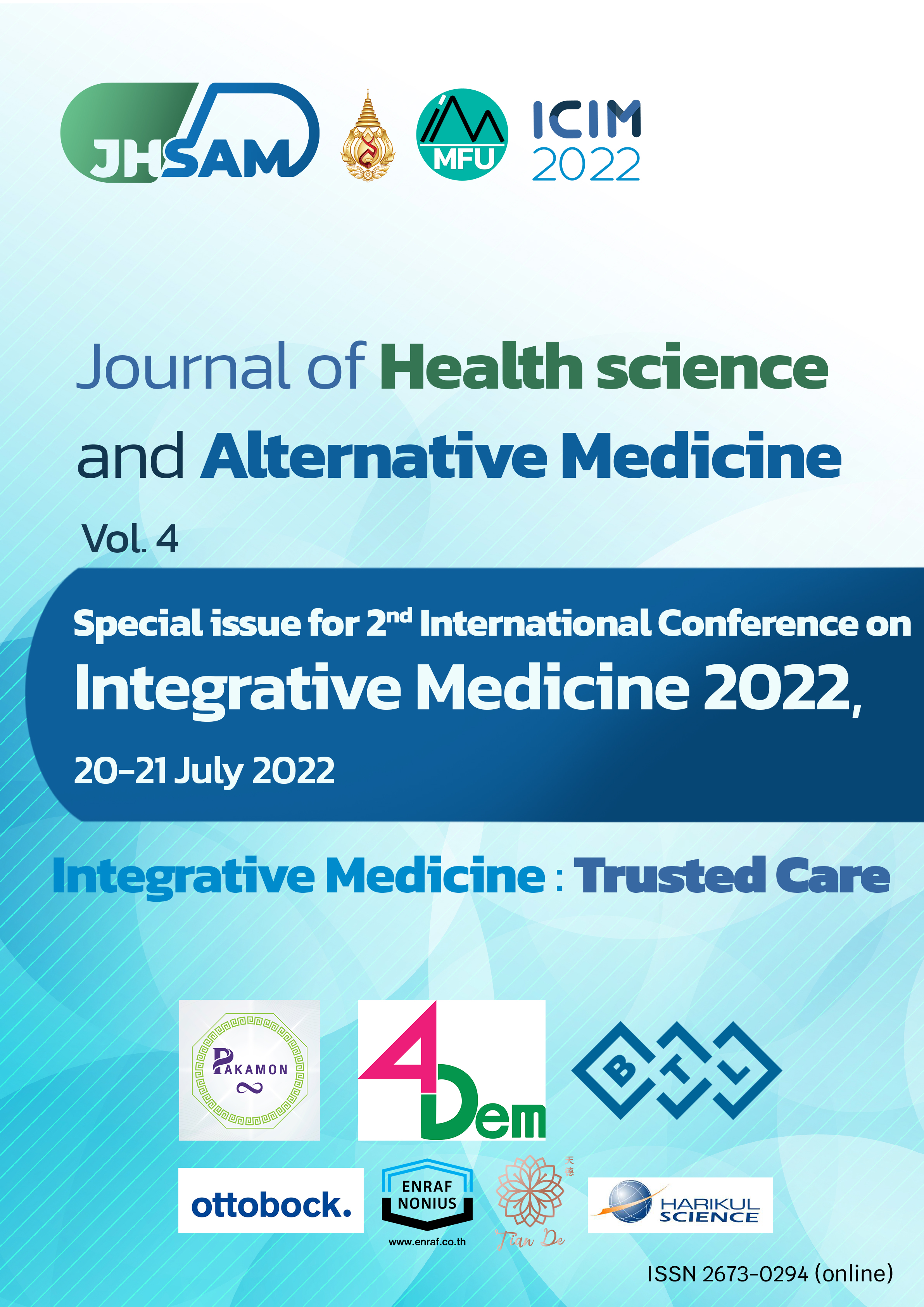C22. Prevalence and Unit Cost of Abnormalities Detected in Abdominal Sonography among Soldiers
Main Article Content
Abstract
Introduction: According to military doctrine, soldiers must maintain their health in order to remain strong and healthy at all times. Furthermore, they must be physically fitter than those in other professions.
Objective: To determine the prevalence of detected abnormalities and the unit cost of clinically significant abnormalities discovered during health screening by abdominal ultrasound (US) in soldiers.study the prevalence of detected abnormalities and the unit cost of clinically significant abnormalities from health screening by abdominal ultrasound (US) among soldiers.
Methods: This was a retrospective study of 841 male and female soldiers who underwent abdominal US health screening at Chulabhorn hospital between February and September 2020. Data collection included abnormalities detected by ultrasound and diagnostic results classified by clinical significance into three categories: abnormality with no clinical significance, abnormality requiring follow-up, and abnormality requiring treatment. The unit cost for those abnormalities is calculated using the list of diagnostic procedures. The most common abnormalities in the United States are fatty liver, liver nodules, gallbladder polyps, renal stones, solid and cystic renal lesions, and prostate gland enlargement.
Results: There were 841 soldiers, 502 males and 339 females, with an average age of 51.8 years. There were 1,043 lesions detected in 643 (76.4 percent) soldiers. Fatty liver affects 364 (43.3 percent) of patients, liver nodules affect 46 (5.5 percent), gallbladder polyps affect 90 (10.7 percent), renal stones affect 41 (4.9 percent), solid and cystic renal lesions affect 128 (15.2%), and prostate gland enlargement affects 113 (22.5 percent). There were 79 abnormalities that were classified as requiring treatment. The unit cost was 19,007 Baht.
Conclusion: The prevalence of abnormalities detected by abdominal US in this study is comparable to that reported in the literature for the general population. As a result, the expectation that soldiers will have fewer abnormalities detected on US soil may not be realized.
Article Details

This work is licensed under a Creative Commons Attribution-NonCommercial-NoDerivatives 4.0 International License.
JHSAM publishes all articles in full open access, meaning unlimited use and reuse of articles with appropriate credit to the authors.
All our articles are published under a Creative Commons "CC-BY-NC-ND 4.0". License which permits use, distribution and reproduction in any medium,
provided that the original work is properly cited and is used for noncommercial purposes.
References
Takahashi H, Kotani K, Tanaka K, Egucih Y, Anzai K. Therapeutic Approaches to Nonalcoholic Fatty Liver Disease: Exercise Intervention and Related Mechanisms. Front Endocrinol (Lausanne). 2018;9:588-.
Gutt C, Schläfer S, Lammert F. The Treatment of Gallstone Disease. Dtsch Arztebl Int. 2020;117(9):148-58.
Trovato FM, Catalano D, Musumeci G, Trovato GM. 4Ps medicine of the fatty liver: the research model of predictive, preventive, personalized and participatory medicine—recommendations for facing obesity, fatty liver and fibrosis epidemics. EPMA Journal. 2014;5(1):1-24.
Wertz JR, Lopez JM, Olson D, Thompson WM. Comparing the diagnostic accuracy of ultrasound and CT in evaluating acute cholecystitis. AJR American journal of roentgenology. 2018;211(2):W92.
Lamberts MP. Indications of cholecystectomy in gallstone disease. Current Opinion in Gastroenterology. 2018;34(2):97-102.
Wiles R, Thoeni RF, Barbu ST, Vashist YK, Rafaelsen SR, Dewhurst C, et al. Management and follow-up of gallbladder polyps. European radiology. 2017;27(9):3856-66.
Tseng TY, Preminger GM. Kidney stones. American Family Physician. 2013;87(6):441-3.
Silverman SG, Israel GM, Herts BR, Richie JP. Management of the incidental renal mass. Radiology. 2008;249(1):16.
Wein A, Lee D. Benign Prostatic Hyperplasia and Related Entities. Penn Clinical Manual of Urology. 2007:479-521.
OSHIBUCHI M, NISHI F, SATO M, OHTAKE H, OKUDA K. Frequency of abnormalities detected by abdominal ultrasound among Japanese adults. Journal of gastroenterology and hepatology. 1991;6(2):165-8.
Rungsinaporn K, Phaisakamas T. Frequency of abnormalities detected by upper abdominal ultrasound. Medical journal of the Medical Association of Thailand. 2008;91(7):1072.
Lee J, Kim T, Yang H, Bae SH. Prevalence trends of non-alcoholic fatty liver disease among young men in Korea: A Korean military population-based cross-sectional study. Clinical and Molecular Hepatology. 2022;28(2):196.
Etminani R, Manaf ZA, Shahar S, Azadbakht L, Adibi P. Predictors of Nonalcoholic Fatty Liver Disease Among Middle-Aged Iranians. Int J Prev Med. 2020;11:113-.
Dima-Cozma LC, Bitere OR, Pantazescu AN, Gologan E, Mitu F, Rădulescu D, et al. Cavernous liver hemangioma complicated with spontaneous intratumoral hemorrhage: a case report and literature review. Rom J Morphol Embryol. 2018;59(2):557-61.
Ali TA, Abougazia AS, Alnuaimi AS, Mohammed MAM. Prevalence and risk factors of gallbladder polyps in primary health care centers among patients examined by abdominal ultrasonography in Qatar: a case-control study. Qatar Med J. 2021;2021(3):48-.
Stinton LM, Shaffer EA. Epidemiology of gallbladder disease: cholelithiasis and cancer. Gut and liver. 2012;6(2):172-87.
Sorokin I, Mamoulakis C, Miyazawa K, Rodgers A, Talati J, Lotan Y. Epidemiology of stone disease across the world. World J Urol. 2017;35(9):1301-20.
Sarkodie B, Anim D, Jimah B. Transfemoral embolization of a large symptomatic renal angiomyolipoma in a horseshoe kidney: a case report and literature review. Health Sciences Investigations (HSI) Journal. 2020;1(2):139-43.
Lepor H. Pathophysiology, epidemiology, and natural history of benign prostatic hyperplasia. Rev Urol. 2004;6 Suppl 9(Suppl 9):S3-S10.
Zhang S-J, Qian H-N, Zhao Y, Sun K, Wang H-Q, Liang G-Q, et al. Relationship between age and prostate size. Asian J Androl. 2013;15(1):116-20.
Dissaneevate K. Results of Lower Abdominal Ultrasound as Part of Whole Abdominal Ultrasound in Patients with and without Indications Related to Lower Abdomen. J Med Assoc Thai. 2017;100(1):S177-S82.
Dereziński T, Fórmankiewicz B, Migdalski A, Brazis P, Jakubowski G, Woda Ł, et al. The prevalence of abdominal aortic aneurysms in the rural/urban population in central Poland — Gniewkowo Aortic Study. Kardiologia Polska (Polish Heart Journal). 2017;75(7):705-10.

